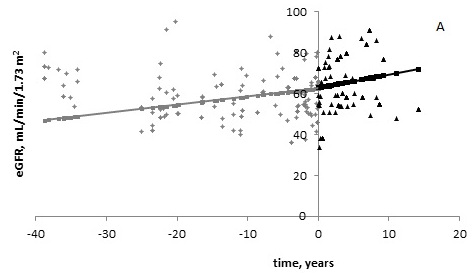Interruption of RAAS in Hypertensive Proteinuric Kidney Donors.
1Department of Internal Medicine, U of MN, Mpls, MN
2Department of Surgery, U of MN, Minneapolis, MN
Meeting: 2017 American Transplant Congress
Abstract number: D250
Keywords: Glomerular filtration rate (GFR), Hypertension, Kidney, Proteinuria
Session Information
Session Name: Poster Session D: Living Donor Kidney Transplant II
Session Type: Poster Session
Date: Tuesday, May 2, 2017
Session Time: 6:00pm-7:00pm
 Presentation Time: 6:00pm-7:00pm
Presentation Time: 6:00pm-7:00pm
Location: Hall D1
The aim of this analysis was to assess the progression of eGFR between proteinuric hypertensive living kidney donors (HTN-LKDs) receiving ACE inhibitors (ACEinh) or angiotensin receptor blockers (ARB) vs. other blood pressure lowering medications (other BPmeds).
Methods. Included in this analysis were 89 HTN-LKD who had proteinuria following HTN, had serial data on eGFR and had records on the type of anti-hypertensive medication used.
Results. The median (IQ) time from donation to diagnosis of HTN was 15.0 (7.2 – 21.7) years and time from HTN to diagnosis of proteinuria was 7.0 (2.0 – 13.9) years. Of the 89 HTN-LKD with proteinuria, 32 (36.0%) were treating their HTN with ACEinh/ARB. At last followup, the proportion with obesity and the number of years since diagnosis of HTN was greater in those on ACE/ARB. Mixed model analysis showed that HTN proteinuric LKDs treated with ACEinh/ARB had an eGFR slope of 0.65 (0.33) mL/min/1.73 m2 per year, p = 0.06.Those treated with other-BPmeds had a decline in eGFR of 1.50 (0.27) mL/min/1.73 m2 per year, p = <0.0001. The interaction term showed that the rate of change of eGFR was different before and after diagnosis of hypertension in those treated with other-BPmeds, p = < 0.0001, but not in those receiving ACEinh/ARB, p = 0.4.
Figure 1. Progression of eGFR in proteinuric HTN-LKD treated with (A) ACEinh/ ARB (B) with other BPmeds.
 Gray and black markers represent the observed pre- and post-HTN eGFR values, respectively per donor. The gray and black lines were regressed on the predicted mean eGFR values as a function of time.
Gray and black markers represent the observed pre- and post-HTN eGFR values, respectively per donor. The gray and black lines were regressed on the predicted mean eGFR values as a function of time.
Conclusion. This analysis suggests that the rate of decline in eGFR observed in HTN kidney donors with proteinuria could be better controlled using ACEinh/ARB alone or combined with other blood pressure lowering medications.
CITATION INFORMATION: Sanchez O, Ferrara L, Berglund D, Matas A, Foley R, Ibrahim H. Interruption of RAAS in Hypertensive Proteinuric Kidney Donors. Am J Transplant. 2017;17 (suppl 3).
To cite this abstract in AMA style:
Sanchez O, Ferrara L, Berglund D, Matas A, Foley R, Ibrahim H. Interruption of RAAS in Hypertensive Proteinuric Kidney Donors. [abstract]. Am J Transplant. 2017; 17 (suppl 3). https://atcmeetingabstracts.com/abstract/interruption-of-raas-in-hypertensive-proteinuric-kidney-donors/. Accessed January 7, 2026.« Back to 2017 American Transplant Congress
